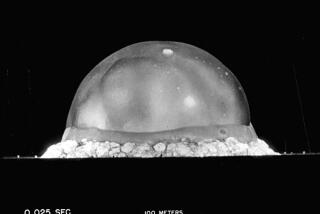Samuel T. Cohen dies at 89; inventor of the neutron bomb
- Share via
Samuel T. Cohen, the father of the controversial tactical nuclear weapon known as the neutron bomb, which was designed to kill people and other living things but inflict minimal damage on buildings and other property, died Sunday at his home in Brentwood. He was 89 and died two weeks after the removal of a cancerous tumor from his stomach, according to his son Paul.
A conventional nuclear weapon releases massive amounts of radiation and heat that incinerates humans and inanimate objects alike, leaving behind radioactive debris that contaminates the area for years or decades. A neutron bomb, or enhanced radiation weapon, in contrast, has only about a tenth the explosive power of a comparable fission weapon, and most of its output is in the form of neutrons — tiny neutral particles that can pass through walls, vehicles, tanks, armor and other inanimate objects with little or no damage.
But those neutrons cause severe, lethal damage to the nuclei of living cells, killing combatants quickly. Because of its limited range, however, there is little risk to civilians not in the field of battle and little or no residual radiation to threaten the environment after the conflict.
“It’s the most sane and moral weapon ever devised,” Cohen said in an interview with the New York Times shortly before his death. “It’s the only nuclear weapon in history that makes sense in waging war. When the war is over, the world is still intact.”
Critics, however, took a different view, contending that the limited damage associated with the neutron bomb would make nuclear warfare more acceptable and that, in turn, could lead to full-scale nuclear retaliation.
Soviet Premier Nikita Khrushchev called the neutron bomb the ultimate capitalist weapon, built “to kill a man in such a way that his suit will not be stained with blood, in order to appropriate the suit.”
Cohen relentlessly promoted the weapon throughout his career, arguing his case before presidents, members of Congress and scientific bodies. Presidents Kennedy, Johnson and Carter rejected it, arguing that it would upset the existing balance of power and test-ban moratoriums.
In 1981, however, President Reagan ordered 700 neutron warheads built to oppose the massive Soviet tank force that had been strategically positioned in Eastern Europe. He viewed the bomb as the only tactical weapon that could effectively stop the tanks without also destroying much of the continent. The weapons were later dismantled in the face of widespread protests and the disintegration of the Soviet Union.
France, China, Russia and Israel are also thought to have produced neutron weapons, but it is not known if they still have any.
Samuel Theodore Cohen was born in Brooklyn, New York, on Jan. 25, 1921, to Austrian Jews who migrated to the United States by way of Britain. When he was 4, the family moved to Los Angeles, where his father worked as a carpenter on movie sets. Young Samuel suffered allergies, eye problems and other ailments, and his mother put him on a rigidly controlled diet, regular purges and daily ice-water showers to toughen him up, and fed him so much carrot juice that his skin was often yellow.
A brilliant student, he studied physics at UCLA, receiving a bachelor’s degree in 1943. After joining the Army, he was posted to MIT for advanced training in physics and math, then selected for work on the Manhattan Project. Although he never received a doctoral degree, he calculated neutron densities on Fat Man, the bomb that was dropped on Nagasaki, Japan.
After World War II, he joined the RAND Corp. in Santa Monica and spent most of his career there. He said the inspiration for the neutron bomb was a 1951 visit to Seoul, which had been largely destroyed in the Korean War. In his memoir, he wrote: “If we are going to go on fighting these damned fool wars in the future, shelling and bombing cities to smithereens and wrecking the lives of their inhabitants, might there be some kind of nuclear weapon that could avoid all this?”
He designed the neutron bomb using pencil, paper and a slide rule given to him by his father for his 15th birthday.
Cohen is survived by his wife of 50 years, the former Margaret Munnemann; two sons, Paul and Thomas, both of Los Angeles; a daughter, Carla Nagler of Santa Fe, N.M.; and three grandchildren.
More to Read
Start your day right
Sign up for Essential California for the L.A. Times biggest news, features and recommendations in your inbox six days a week.
You may occasionally receive promotional content from the Los Angeles Times.






